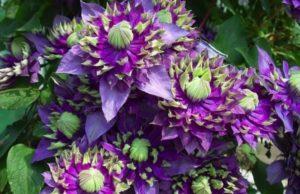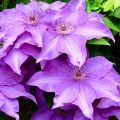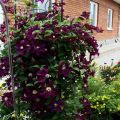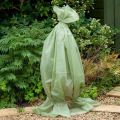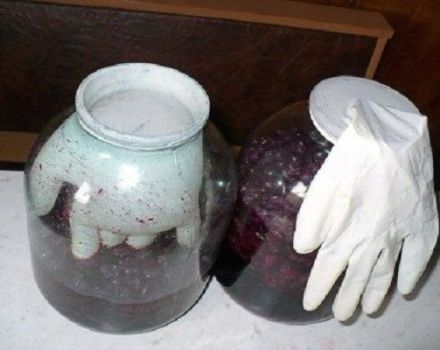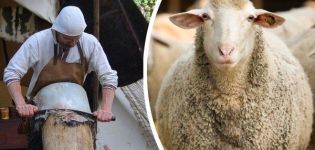Description and cultivation of clematis varieties Ernest Markham, pruning group
Clematis are widespread throughout the world; the variety of colors and shapes of their flowers does not leave indifferent any gardener. Large-flowered clematis with bright and abundant flowering, to which Ernest Markham belongs, look especially impressive. But he will not grow successfully by itself, you need to know the features of the rules of care and follow agricultural techniques.
Description and characteristics of clematis Ernest Markham
This is an English variety of clematis with large flowers, up to 15 centimeters in diameter. They are slightly velvety, saturated, lilac-reddish, sometimes bright red with a light core. The variety blooms late, on young shoots of the current year - from July, but blooms for a rather long time, until October. Scourges grow to a height of 3-4 meters. The applicant is breeder Ernest Markham.
Advantages and disadvantages of a flower
This hybrid large-flowered clematis is deservedly popular among gardeners, but in addition to obvious advantages, it also has some disadvantages.
Strengths:
- Ernest Markham can grow in the open sun. Flowers do not get burned and do not lose the saturation of light;
- bright, spectacular, abundant clematis bloom;
- adult clematis has good growth force, quickly builds up numerous lashes;
- Ernest Markham is able to climb supports, fences, gratings;
- clematis is suitable for growing in large containers or pots;
- disease and pest resistance;
- good indicators of frost resistance, up to -35 C degrees (USDA zone 4-9) and drought resistance.
Weaknesses:
- late flowering period, in the northern regions, with early frost, flowering period will be short;
- in young plants, growth retardation may be observed; stimulation with nitrogen fertilizers is necessary.
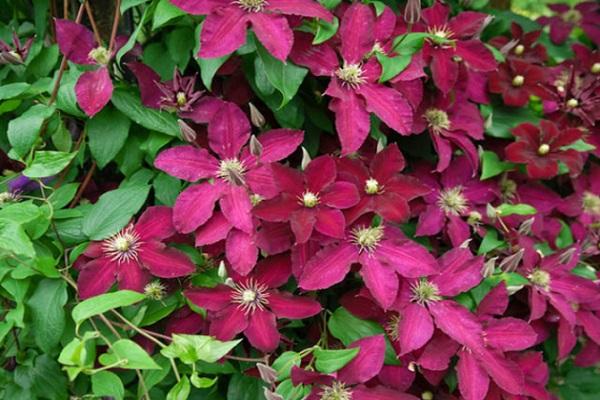
Planting culture rules
To get a luxurious, beautifully flowering bush in the future, the gardener must correctly choose and plant clematis seedlings.
Boarding time
Clematis with an open root begin to be planted as early as possible - when the soil warms up a little. In the south - from the beginning of April, in other regions it is possible to plant from May. The main thing is not to plant clematis with ACS in the heat, but if there is no choice, then after planting it is imperative to mulch the soil and shade for the first time.When buying seedlings with ZKS (in pots), they can be planted throughout the season, but when planting in the summer, the first time it is necessary to shade during the day.
Site selection and soil preparation for planting
Ernest Markham shows the greatest decorativeness when grown in sunny places. But in the southern regions it does not lose its effectiveness even when placed in partial shade. Before disembarking, it is necessary to prepare a landing hole, 40-50 centimeters deep and wide.
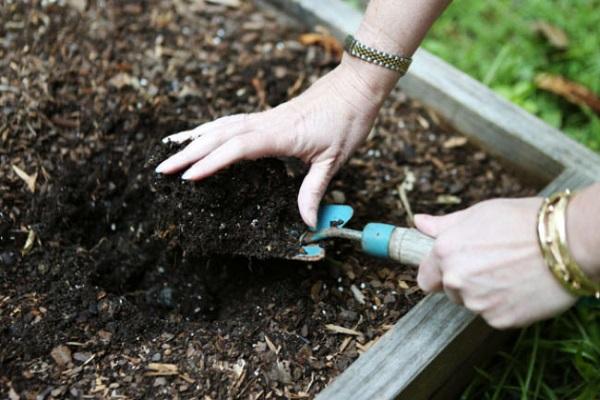
It is filled with planting substrate, which consists of 3 parts of light, non-acidic peat, 1 part of well-rotted manure and 1 part of coarse sand or agroperlite. You can add a couple of tablespoons of wood ash and finely chopped sphagnum moss.
Selection and purchase of planting material
Seedlings with an open root system should have developed, 15-20 cm roots and several pronounced growth buds. The roots should not be sick, rotten, with a rotten smell, have a yellowish brown or orange color. When choosing potted seedlings, they should have at least a few young, strong shoots. It is advisable if the roots are already peeking out through the drainage holes.
Planting process
Seedlings in pots (with a closed root system) are placed at the bottom of the planting hole, with a depth of up to 10 centimeters, sprinkled with soil, tamped and spilled abundantly with water. When planting seedlings with an open root, a substrate is poured into the bottom of the hole with a mound, the roots are spread on it. They are also buried up to 10 centimeters, sprinkled with earth, slightly compacted and watered well.
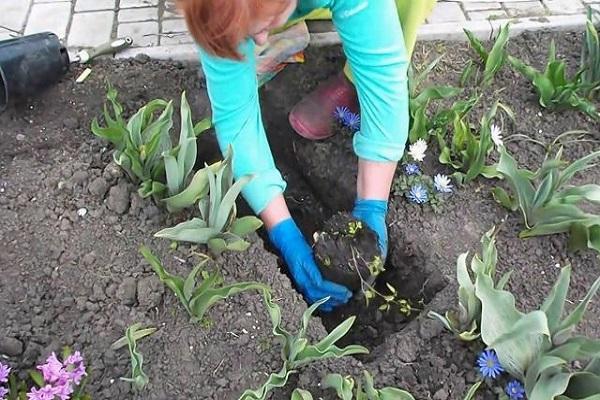
Care advice
To maintain high decorative qualities and overall health of the Ernest Markham bush, it is necessary to properly cut, feed and water.
Watering
The frequency of watering depends on the type of soil, the frequency of precipitation and the growing region. Mulching the soil allows for less wetting. It is important to remember that clematis will kill stagnant water faster than drought.
But for the successful development of the plant, it is necessary to carry out abundant watering several times a week, especially in the hot season.
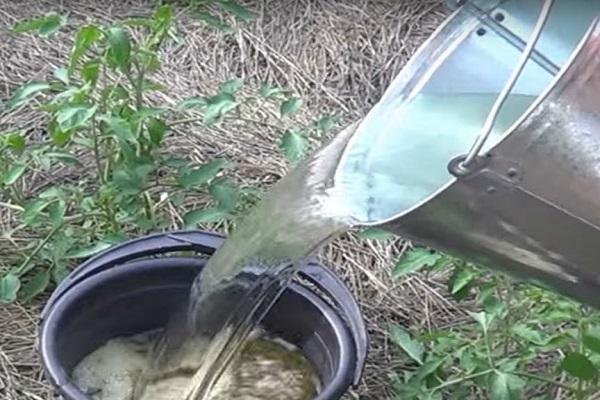
Top dressing
Abundantly flowering, large-flowered varieties require a complete, balanced diet, depending on the stage of development. At the beginning of the growing season, more nitrogen is needed; during flowering, the consumption of phosphorus and potassium increases.
Pruning
Ernest Markham belongs to clematis, which are characterized by III pruning group (full). In the fall, all the whips on the liana are cut "to zero", flush with the soil level, or only a couple of knots are left. In the spring, new shoots grow, on which flowers are formed.
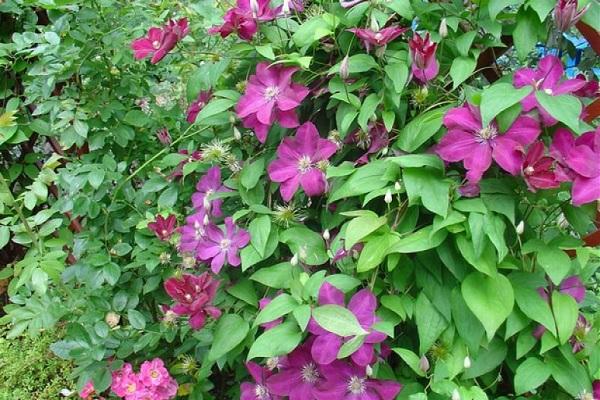
Mulching and loosening
Clematis prefer that their root zone is protected from direct sunlight. Beautifully and effectively, you can plant "at the feet" of his ground cover plants with a shallow root or flowers. Marigolds are perfect, in addition to protecting clematis from nematode damage.
The correct agricultural technique will be mulching the root zone with a thick (up to 20 centimeters) layer of organic matter. If you use green manure, in particular mustard, in addition to enriching the soil, it will also serve as the prevention of many diseases.
In the presence of mulch, the need for loosening the root zone disappears. With bare soil, loosening is necessary up to 3-4 times a month, depending on the type of soil (on heavy soils, more often) and the frequency of watering. In addition, loosening not only facilitates the access of oxygen to the roots of clematis, but also helps in the fight against weeds.

Preparing for winter
Preparing Clematis Ernest Markham for winter consists in performing simple, sequential tasks:
- sanitary cleaning and pruning of leaves and shoots;
- preventive spraying with a copper-containing fungicide, for example, copper sulfate;
- removal from the trellis onto a previously prepared flooring (needles, agrofibre, burlap);
- shelter with warm, breathable material (for example, agrofiber).
Diseases and pests
Clematis are susceptible to many diseases and pests. Ernest Markham is resistant to the main ones, but to maintain health, 2-3 preventive spraying with chemicals is necessary. Moreover, insecticides and fungicides can be used in one tank mixture, provided they are compatible. For example, Ridomil Gold and Aktara. Adding an adhesive will not be superfluous to prevent the preparation from dripping from the leaves.
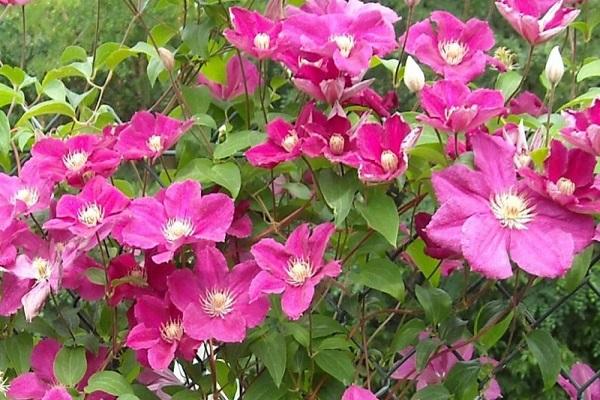
Breeding methods
Summer residents can propagate their favorite variety themselves, including Ernest Markham, using the method of cuttings, dividing the bush or dropping layers.
Layers
A good way to propagate clematis is to dig an almost stiff whip in the groove next to the bush. It is pinned with staples for fixation at a depth of 10 centimeters, and sprinkled with earth. Then it is poured abundantly with water and mulched on top. It is important to monitor the regular moistening of the excavation; after 2-3 months, a rooted clematis seedling is formed at each node of the lash.
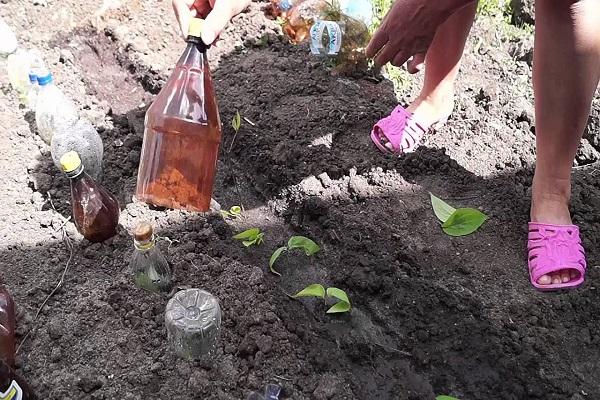
Cuttings
Clematis reproduces well with semi-lignified cuttings. The best time for grafting is spring or early summer. It is best to prune them before flowering. A piece of stem is cut off, preferably from the middle part of the vine, with one or two nodes; the bottom edge is trimmed at an angle, and the top edge remains straight.
After dusting the lower cut with a rooting stimulator, it is placed in a greenhouse or greenhouse, where it is regularly sprayed until the roots grow back.
By dividing the bush
Clematis, starting at 3 years of age, are propagated by dividing the bush. It is dug up and neatly divided into parts of the stem with a piece of root. There are few seedlings, but they are quite powerful.

